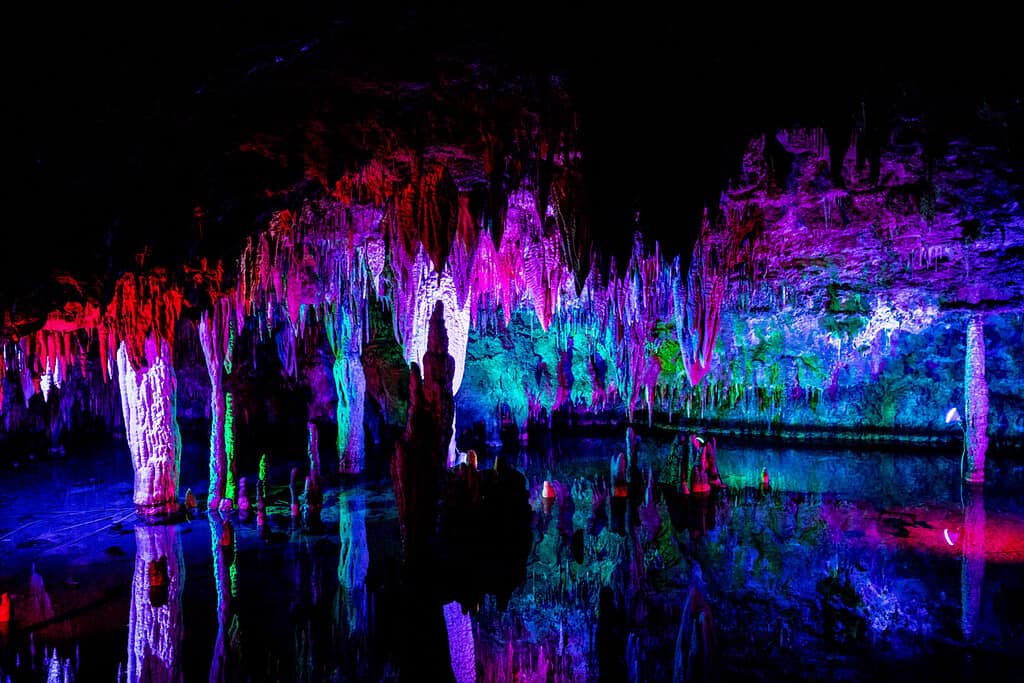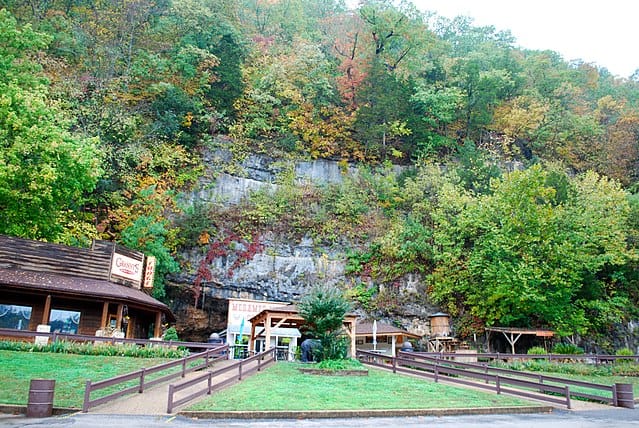150,000 visitors flock to see these caverns for themselves each year. It’s the biggest commercial cave in the state, after all. Plus, these winding underground passageways and chambers hold pieces of history, including the hideout Jesse James used in the 1870s. Discover Meramec Caverns, including what lurks inside these massive Missouri caves!
History of Meramec Caverns
Meramec Caverns was first known as Saltpeter Cave. In 1720, a French explorer by the name of Philip Renault grew intrigued when an Osage Indian guide told him that there was a cave off the Meramec Riverbank that had shimmering yellow metal. Renault wanted to explore the area to see exactly what he was talking about. He set off and quickly found the cave. It was 20 feet high and 50 feet wide.
Although he thought he would discover gold within its walls, he found saltpeter (also known as potassium nitrate). At the time, this was an integral ingredient used for gunpowder manufacturing. So, Saltpeter Cave led to well over 100 years of mining. In 1864 during the Civil War, mining at the cave ended after Confederate troops obliterated a facility within the cave. In the 1890s, the cave became something completely different.

Today, Meramec Caverns have modern lighting, adding to its mesmerizing appeal.
©Mia2you/Shutterstock.com
Locals started holding parties in the cave because it offered a cool retreat when the summer brought hot weather. They had a dance room to enjoy for a bit over 10 years. Then, in 1933, a man named Lester Benton Dill, who had a lifelong interest in caves, took possession of it. He realized that Saltpeter Cave was a lot bigger than many thought and he changed the name to Meramec Caverns. Then, he started offering cave tours so others could discover Meramec Caverns as well.
Geology and Geography of Meramec Caverns
Though discovered only a couple hundred years ago, the site of Meramec Caverns has existed for hundreds of millions of years. These caverns slowly formed over time via limestone deposits. The entire system spans 4.6 miles and is located under the Meramec Valley, close to the city of Stanton in Missouri.
Meramec Caverns are made up of stalagmites, stalactites, and columns. Protruding from the ceiling these deposits resemble icicles. This natural occurrence is the result of water dissolving, exposing limestone, and re-depositing calcium carbonate throughout the cavern walls.
What Lurks Inside Meramec Caverns
When you discover Meramec Caverns, you realize there are seven levels. There are different passageways along with well-lit chambers, some set up to memorialize events that took place within the caverns years ago. For instance, you can see Jesse James’ supposed hideout within the caverns. It’s said that during the 1870s, Jesse James used this area to hide out along with several men and horses.
You also get to see the Stage Curtain, which is the cave’s most impressive natural formation. Its name is apt because it resembles drapes. There’s also a massive chamber inside the cavern known as the Ballroom. Here, people host both private and public events. The passageways underground are breathtaking with each step you take and above the caverns are zip-lining opportunities.
Wildlife inside the cave includes a rare crustacean: the Onondaga Cave amphipod. This unique creature inhabits the water-filled environments underground, including drip pools and cave streams. Additional animals that call these caverns home include the Indiana bat, northern long-eared bat, eastern pipistrelle, little brown bat, and gray bat. Bats serve a special purpose underground. Since their diets consist of insects, they snatch them up for sustenance, including pesky mosquitos. These protected environments allow bats the opportunity to thrive.

Little brown bats sleep for an average of 20 hours per day to conserve their energy.
©Ondrej Prosicky/Shutterstock.com
Visiting Meramec Caverns
If you’re interested in visiting Meramec Caverns, the good news is that it’s open every single day. The only two days that you won’t be allowed in include Thanksgiving and Christmas. They open at 9 AM and stay open until 4 PM, 5 PM, 6 PM, or 7 PM depending on the time of year. The walkways are well-lit throughout and you can follow along with a trained ranger on a guided tour. These tours start every 20 to 30 minutes so no matter the time of your arrival, you soon get the opportunity to start a tour. The tour takes a total of one hour and 20 minutes, and you walk 1.25 miles round trip.
The temperature inside the cave remains steady at 58 degrees Fahrenheit, so a light jacket is a good idea. Though there are bats, you’re unlikely to see them due to their nocturnal schedules. In the Theatre Room, you can enjoy an LED light show that showcases the attraction of America. It was installed in 2014 and serves to memorialize the armed forces, police officers, and other emergency professionals who sacrificed their lives on September 11, 2001.
Thank you for reading! Have some feedback for us? Contact the AZ Animals editorial team.








